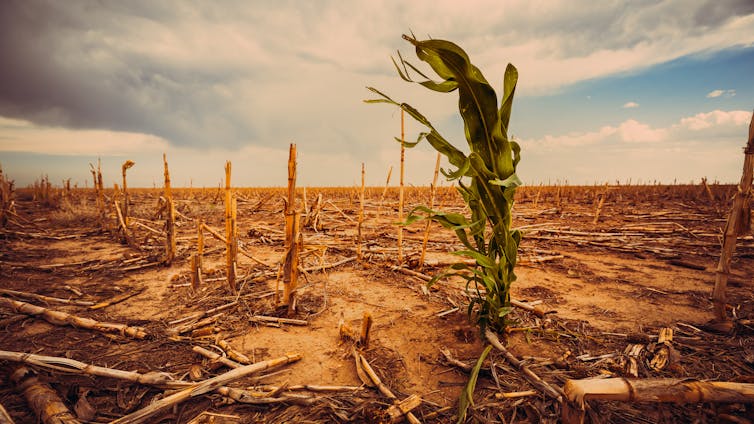
[ad_1]
Every year, the world loses 5 million hectares of forestsWith 95 % of these forest removal that occurs in tropical areas. South America is a major hot point, as Brazil faces in particular the loss of severe forests – most of which are driven by livestock, which represents more than 70 % of all Amazon forest removal.
Many of these cleansing are performed by farmers, especially those with small holders, who are trying to deal with intense dehydration and other effects of climate change. This leads to a paradox: the most exposed people to climate threats are often pushed through survival stress to make options that increase the deterioration of the environment.
Imagine standing in a field of dry, cracked soil, and watching the crops you planted with hope fails to grow. He did not get a few months ago. You know that cultivation of trees can help protect your land and water sources in the long run. But you need food next week.
Instead, you can wipe some forests to sell wood and raise some cows – an option that may get you during the season, even if it reduces soil moisture and keeps water on your farm.

Get your news from the actual experts, directly to your inbox. Participate in the daily newsletter to receive all the recent coverage of news and research, from politics and works to arts and sciences.
As one of the farmers told me: “The problem is: Does the agricultural product die now, or is he died later? Now, he dies of hunger. At a later time, he dies of thirst. It is preferable to die later from thirst.”
This is what my team of environmental researchers “climate trap” calls: a vicious cycle where the short -term survival decisions deepen the short -term climate. our A recent study This phenomenon is looking for small cocoa producers in the south of Brazilian state of Bahia.
We followed more than 3000 farms for four years, and we conducted dozens of interviews with farmers. One of our most surprising results was that the most affected of dryness were less likely to use adaptive strategies such as re -embarrassment, and they are more likely to make environmental harmful options such as forest disinfection of the pasture.
This contrasts sharply with research from high -income countries, as it encourages more climate risk to preventive work. Why the difference?
The answer, according to our research, lies in passion. Many farmers have talked about fear and despair. One of them told us: “We plant, plant, die. Plant, planting, dies.
These feelings affect the decisions. When fear and despair started, people naturally narrow their focus in the short term – what can I control today?

Scott book/Shutterstock
The future becomes very uncertain, and very frightening to plan it. As one of the farmers explained: “Today, I work more in the short term.
Even when farmers understand that long -term strategies such as reintegration will help, these solutions can feel the emotional and economic stress.
We call this non -adapted feedback loop: climatic trauma leads to emotional distress, which limits long -term thinking, which leads to environmental harmful choices that increase future weak shocks. The course is repeated.
Learning from the episode
Climate traps are real and perhaps more prevalent than many people realize. Similar dynamics were reported in parts of Africa and Asia and across the developing world. These are societies that face climate change with the lowest number of resources to respond.
To discover climate traps, companies and governments need to realize when incentives in the short term causes long -term damage. If the decision solves an immediate problem, but it increases the risk of climate over time, this may be part of the trap.
They need to pay attention to indicators such as removal of repeated forests after dehydration, or switching from sustainable crops to rapid repair options such as livestock pasture. In areas that are severely affected by climate change, these responses often indicate a deeper cycle of survival in the short term and long -term weakness.
Also, listen to the resignation. Phrases like “There is no feasibility” and “we are only alive but we can” or “there is nothing we can do except for prayer for change” may indicate emotional fatigue-which indicates the agency’s loss and the decrease in faith in the long-term work benefit.
When people no longer think that their efforts can make a difference, the best technical solutions are likely to be ignored.
Climate adaptation is more than just providing technical solutions. In our study, the producers were well aware of the pros and cons. The real barriers were emotional.
We believe that interventions need to address fear and despair directly-through the use of safety networks, financial temporary stores and support systems led by society, as well as accounts that rebuild a sense of control and agency. Reducing despair not only requires money, but existence. Trusted consultants, peer learning networks and visual examples of successful adaptation can help.
Avoid climate traps is not easy. But in order for climate adaptation to succeed – especially if you need more – we have to stop dealing with emotions as a side issue. They are central. The solutions we provide to the mind and heart must speak.

You don’t have time to read about climate change as much as you want?
Get a weekly tour of your inbox instead. Every Wednesday, the environment editor writes in the conversation, imagine, a short email message that is slightly deeper in only one climate case. Join more than 45,000 readers who have subscribed so far.
